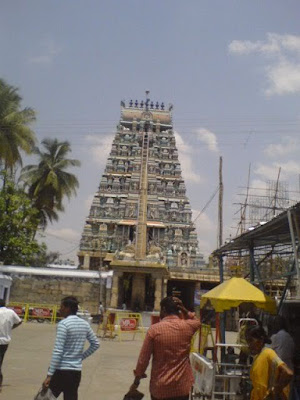
"Veedu Varai Uravu
Veedhi Varai Manaivi
Kaadu Varai Pillai
Kadaisi Varai Yaaro?"
meaning - When a man dies, his relatives and friends come till his home. His life partner (wife) come till the street. His children come till his body is cremated. But nobody knows who/what will accompany that soul after that.
Veedu - Home
Varai - till, until
Uravu - relatives, friends
Veedhi - Street
Manaivi - Wife
Kaadu - Forest, Burial/Cremation ground
Pillai - Son/Children
Kadaisi - End
Yaaro - Interrogative pronoun indicating Who?
However the well known siddhar Pattinathar (circa. 11th Century) has an explanation to this question about who the companions are? His song goes on the same lines as above.

"Aththamum Vaazhvum Agathumattae Vizhi Ambozhuga
Meththiya Maadharum Veedhi Mattae Vimmi Vimmi Iru
Kaithalam Mael Vaithu Azhum Maindharum Sudukaadu Mattae
Patri Thodarum Iruvinai Punniyam Paavamumae"
meaning, Wealth and Relations coming till the home. Women - The wife - with their attractive eyes come till the street. The children who cry keeping their hands on the body come until the cremation grounds. The two things that accompany are the sins and the good deeds that a person does during his life.
Aththam - Wealth,Relations
Vaazhvu - Living
Agam - Home
Mattae - Till
Vizhi Ambu - Attractive Eyes (Vizhi) striking the view like an arrow (Ambu)
Meththi - Praise
Maadhar - Women
Veedhi - Street
Vimmi - Spasmodically gasping while crying
Iru Kai - Both hands
Mael Vaithu - Keeping on top
Azhum - Crying
Maindhar - Children
Sudukaadu - Cremation ground
Patri - Clasp
Thodarum - Continue
Iruvinai - Two karmas
Punniyam - Good deeds
Paavam - Sin
Pattinathar has so much to be said about him, that it will take up a few posts to fully cover and convey his sayings. To give a brief about Pattinathar - He was a highly influential and a very rich businessman, who attained realisation/enlightenment by his own son who was none other than Lord Shiva incarnate. The one verse by his son made Pattinathar attain realisation about the existence of a soul and its ultimate path. The verse is

"Kaadhatra Oosiyum Vaaradhu Kaan Kadai Vazhikkae"
This has two meanings that can be interpreted. The first, The needle with a broken eye, will never make its way to the market. The second, which was the culmination of Pattinathar's realisation, means that even the useless needle with a broken eye would not accompany in the human's last journey
Kaadhatra - Kaadhu refers to Ear, however in this context it refers to the eye of the needle
Oosi - Needle
Vaaradhu - Will not be coming
Kaan - See
Kadai - Shop, Market, Last, End
Vazhi - Path, Destination
The wealth earned, the people whom relationships are built, even their wife and offsprings would not accompany during their final journey. His intention is not get dejected in life that nothing is going to come with us in the final journey and why should one put in efforts to gather wealth. But to make a note that the good deeds and the sins are the ones that we have with us in all our lives. So we need to minimize the sins that we commit and increase the good deeds that we perform. So setting our expectations low, will avoid unnecessary desires which is the root cause of all troubles and tribulations that a person goes through and is the thing that pushes a man to committing a sin. And the belief is that if you commit less sins and more good deeds, you will be reborn as something better than what we are now. Be it for the reasons of rebirth or not, let us try to avoid committing sins in our lives.
More to come, until then...










































